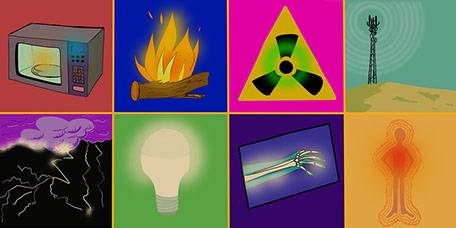SciGen Teacher Dashboard
Flash to Bang
Waves without a Medium
The Electromagnetic Clothesline
Making the Invisible Visible
All-Star Alien Hide and Seek
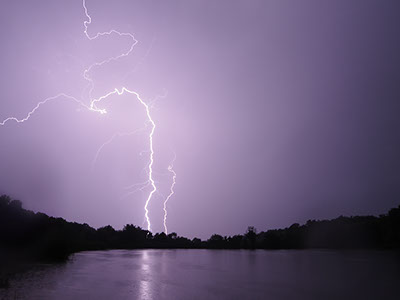 Scene: Flash to Bang
Scene: Flash to Bang
Duration: Approximately 50 minutes
In this Science Scene, a dialogue to read aloud as a class, students play the three roles of Denzel, Riley, and Jordan. The three friends discuss different kinds of waves, both mechanical (like sound) and electromagnetic (like the light emitted by lightning).
LEARNING OBJECTIVES
Students are introduced to the Focus Words, scientific language used throughout this unit.
Students demonstrate careful reading by identifying accurate details.
Students consider the perspectives of the characters through related questions.
Teacher Tips
- Think ahead about how you will assign the three roles (Denzel, Riley, and Jordan) to read the script aloud as a class (or, less ideally, in small groups). Note that students often willingly take on roles regardless of the gender of the characters.
- Another approach is to ask for volunteers to rehearse while you (the teacher) reads the dialogue to the class a first time. The student volunteers then perform a second time, before all table-based groups choose roles and read it a third time.
- While it is possible for the students to read the PDF of the script online, we suggest printing the script for the students so they can hold it in their hands and mark it as they read.
- Consider scaffolding the lesson for English language learners: you could let them preview the script before the lesson or read the dialogue silently once and ask questions to a partner.
- Prior to the reading the script, explain to students that they will encounter new vocabulary terms and ideas that may not be familiar. Reassure them that this lack of familiarity is okay. The reading is meant to introduce the ideas, not explain them completely.
- Review the focus words of the week. The focus word chart linked on the unit overview page should be used as a resource for students to review definitions and sample sentences.
- Some students may not respond well to the unfamiliar terminology used when describing waves. Judge whether your students would absorb the material better if you use the word "electromagnetic" or abbreviate it "EM." Calling all EM waves "light waves" is simpler and technically accurate (since all EM waves travel at the speed of light) but may confuse students who will think only of visible light. For more on challenges using text, see the SERP materials on Reading to Learn in Science.
Teacher Tune-ups
Teaching Notes
ACTIVITY OVERVIEW
- Set the context (10 minutes)
- Engage with the script (20 minutes)
- Review the dialogue through writing and discussion (10 minutes)
- Turn & Talk (10 minutes)
Set the context (10 minutes)
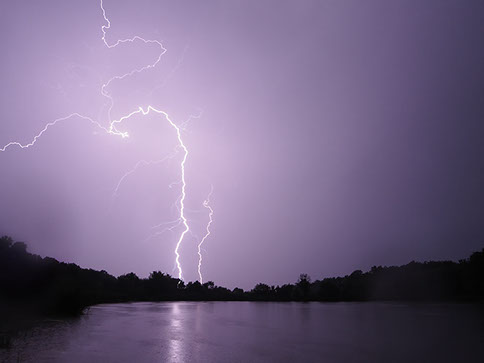
Display image. Paraphrase:
Who has seen lightning? How close have you been to it?
Do you know how to figure out how far away a lightning storm is from where you are standing?
If someone does know the trick of counting seconds and dividing by five to get the distance of the lightning strike in miles:
Can you explain why that works?
Engage with the script (30 minutes)
Some teachers have several groups of students read at the same time. Other teachers select a few students to "perform" in front of the class.
The story begins with the students discussing a thunderstorm. They count the seconds from the flash of the lightning to the bang of the thunder. They discuss the difference between
Focus Words for this unit:
- electromagnetic
- spectrum
- visible
- radiation
- ultraviolet
- infrared
- microwave
- radio
- transmission
- medium
- wavelength
- frequency
- analog
- digital
While most of the Focus Words appear in this script, there are a few terms (ultraviolet, infrared, microwave, analog, digital) that appear in other activities in this unit which aren't used in the student dialogue.
Assigning Roles and Reading Aloud
You may want to read the entire passage out loud to the class once before assigning roles to students or dividing up into groups.
If you'd like, you can assign a fourth role: Thunder yells out "BOOM!" three times, each time a little louder.
The Script
While at their school’s overnight camp, Denzel, Riley, and Jordan are wading in a pond. The sky has grown dark.
Jordan: Looks like rain.
Riley: Yeah, you can tell it’s pouring already, way over those hills.
Denzel: Ooh! Can we go swimming in the rain? I’ve never done that!
Jordan: No way, not in a thunderstorm. Lightning can kill you.
Denzel: Is this a thunderstorm? We didn’t have any where I grew up.
Riley: Oh, right. The California desert.
Denzel: Sort of. I was on the coast. Thunderstorms are really rare there. I never saw lightning until I moved here.
Jordan: Whoa! Did you see that flash?
Denzel: Oh, man, did I just miss it?
Jordan: It was barely visible. Wait for it….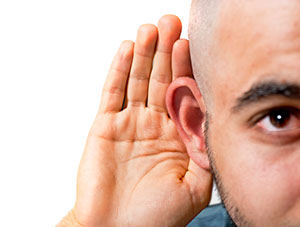
Riley: (mumbling) two Mississippi three Mississippi four Mississippi five Mississippi six…
Denzel: What does Mississippi have to do with anything? We were talking about California.
Riley: (mumbling, a little louder) …15 Mississippi 16 Mississippi 17 Mississippi…
Jordan: I think that Riley is counting seconds.
Riley: (mumbling, even louder) …20 Mississippi 21 Mississippi 22 Mississippi…
Jordan: Every “Mississippi” is another second. We should have used a stopwatch instead.
Riley: 32…Mississippi…
The thunder roars, "BOOM!"
Riley That must have been really loud right under the thunderclap, given how loud it is here, just about … six and a half miles away.
Denzel: How do you figure?
Riley: You just count the seconds. Sound travels a mile every 5 seconds, so you divide the number of seconds by 5 to get the miles. In this case, 32 divided by 5….
Denzel: Ah, I get it. That’s 6.4.
Riley: Yeah, like I said. About six and a half miles away.
Jordan: When I was a kid, the summer camp counselors called counting the seconds "flash-to-bang."
Denzel: Ha! “Flashtobang” would be a good superhero name.
Jordan: Well, it can save your life, for sure. At camp we had to seek shelter whenever we counted any less than 30 seconds from flash to bang.
Riley: Hmm. We were pretty close to 30.
Jordan: If you said Mississippi a little slower, we might have only gotten 29. If lightning strikes again, let’s use my stopwatch, and leave Mississippi out of this. I’ve got it ready.
Denzel: Ooh! There’s another flash of lightning! Go!
The three friends huddle around the phone.
Riley: (every five seconds) One mile... Two miles... Three miles...
The thunder roars a second time, louder, "BOOM!"
Riley: Whoa, just 18 seconds this time. It’s getting closer. Grab your shoes. Let’s head inside the concert barn.
Denzel: I don’t get it. Why do we start counting when we see the lightning? Shouldn’t we add the time that it takes for the light of the lightning flash to get to us?
Riley: It would be such a small number.
Jordan: Riley’s right. Light travels at a million miles a second or so, am I right?
Riley: Not quite. It travels that far in about six seconds. Any place on Earth, though, is less than a tenth of a second away, when you travel at the speed of light.
Jordan: Denzel, traveling at the speed of light should be the superpower of your superhero, Flashtobang.
Denzel: Good idea! One thing I do know about light and sound is that they are both made up of waves. Why is sound so much slower than light?
Jordan: Hmm. That’s a good question. Maybe they’re different kinds of waves. Sound travels by moving molecules around, doesn’t it? The speed of sounds must have something to do with how fast molecules bump into each other.
Denzel: But doesn’t light from the lightning travel through the same air that the sound of a thunderclap does?
Jordan: Yeah… on the other hand, light can get transmitted without needing air or anything else to travel through, right, Riley?
Riley: Yup! Light can even travel through the vacuum of space, but sound waves can’t. We can see stars billions and billions of light years away, but thank goodness we can’t hear them! I bet they would roar!
Denzel: If sound waves can’t travel through space, then how do radio telescopes work? Aren’t they listening for sounds from extraterrestrial civilizations, from the far reaches the universe?
Riley: Radio waves are another kind of wave transmission, more like light waves.
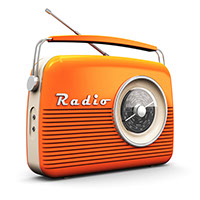 Jordan: That’s confusing. Radios make sound. Aren’t radios making sound waves?
Jordan: That’s confusing. Radios make sound. Aren’t radios making sound waves?
Riley: Yes and no. Radios turn the waves on a single frequency into signals they send to their speakers, and speakers make sound. A radio receives radio waves that were transmitted from a radio station. Radio wavelengths can be kilometers long!
Denzel: I guess those huge radio waves make the floor shake when we crank up the volume on the speakers.
Riley: Actually, the radio waves keep on going through the floor and out the door. It’s the sound waves that make matter move.
Denzel: Oh, yeah! My sensei collects audio equipment she stores at our karate dojo, and she showed me how speakers have parts that move in and out to make waves. The louder the volume, the more they move to make the sound louder.
Riley: Right! Radio waves aren't sound waves, though. They don't need a medium. Light waves and radio waves are two kinds of radiation on the electromagnetic spectrum.
Denzel: Radiation? That sounds dangerous.
Riley: Some electromagnetic waves are dangerous, especially out in space. The earth and its atmosphere and magnetosphere protects us from most electromagnetic waves—they are everywhere.
Jordan: Everywhere? I don't see anything...
Riley: Um... You don't see anything? Jordan, the only reason ANYTHING is visible is because of light waves!
The sky lights up with a crack of lightning that lights up the room at the same time that the thunder roars, the third, loudest "BOOM!"
Jordan: Whoa! We don’t need my stopwatch to tell us where that storm is!
Denzel: (looking a little jittery) Yup. The floor’s not the only thing shaking now!
Review the dialogue through writing and discussion (10 minutes)
Comprehension Questions
![]() Why did the friends start counting when they saw the flash of lightning? Why didn't they calculate the time it took the light to get to them?
Why did the friends start counting when they saw the flash of lightning? Why didn't they calculate the time it took the light to get to them?
![]() At the speed of light, what’s the most time it takes to get between any two points on Earth?
At the speed of light, what’s the most time it takes to get between any two points on Earth?
![]() Use science terms from the dialogue to describe what light and sound have in common.
Use science terms from the dialogue to describe what light and sound have in common.
![]() What can’t sound waves do in the vacuum of space (where there is no air), that light waves can?
What can’t sound waves do in the vacuum of space (where there is no air), that light waves can?
![]() Are radio waves more like light waves or sound waves? Explain your answer.
Are radio waves more like light waves or sound waves? Explain your answer.
When finished with the Science Scene, ask students to answer these four questions.
You may opt to assign single questions in the third section, rather than having all the students answer all the questions. Students can discuss with their partners and try to reach an agreement about their answers to the questions. This activity is an opportunity for students to practice using scientific language as they discuss the questions.
Possible answers:
- The friends started counting when they saw the flash of lightning to calculate its distance. They did not account for the time it took the light to get to them, because it would be a tiny fraction of a second (since the speed of light is 300 million meters per second or 670 mph).
- The maximum amount of time it takes to get between any two points on Earth, traveling at the speed of light, is less than a tenth of a second.
- Light and sound are both waves.
- Sound waves cannot move in the vacuum of space without a medium to move through. Light waves can.
- Radio waves are more like light waves.
Turn & Talk (10 minutes)
In this part of the activity, students consider the waves they see all around them.
Paraphrase:
We've talked about sound waves, radio waves, and light waves. Light and radio waves are part of the electromagnetic spectrum. Sound waves are not.
Have you heard of the electromagnetic spectrum? Denzel thought it sounds dangerous, and Riley said that electromagnetic waves are everywhere.
Ask:
What other kinds of electromagnetic waves have you heard of?
Do any of these things make electromagnetic or other kinds of waves?
As the students generate answers and other ideas for things that make EM waves, you may want to organize their answers into this Venn diagram. Encourage students to add their own ideas beyond what is shown in the pictures.
Possible answers:
Yes, all of the items pictured make waves.
- Microwaves heat the molecules of food.
- A fire produces infrared heat, visible light, crackling noises as sound waves.
- Radioactive elements like uranium emit gamma rays.
- A cellular tower transmits radio waves.
- Storms make visible light and gamma rays in lightning, and the sounds of thunderclaps.
- Light bulbs make visible light.
- X-ray machines make x-rays!
- Humans radiate infrared heat, and we all have some radioactive potassium in us.
BETA Version - Please send comments and corrections to info@serpinstitute.org
